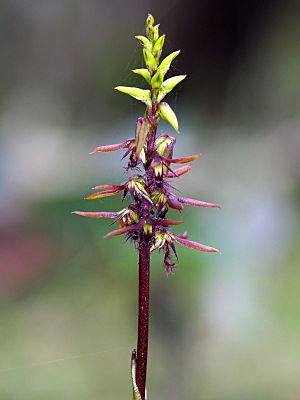Bearded midge orchid facts for kids
Quick facts for kids Bearded midge orchid |
|
|---|---|
 |
|
| Scientific classification | |
| Genus: |
Genoplesium
|
| Species: |
morrisii
|
| Synonyms | |
|
|
The Bearded Midge Orchid (scientific name: Genoplesium morrisii) is a tiny and special type of orchid that grows only in south-eastern Australia. It's also known as Corunastylis morrisii in Australia. This small plant has a single thin leaf that is joined to its flowering stem. It can have up to fifteen small flowers that are dark purplish-black or a mix of green and purple.
Contents
What Does the Bearded Midge Orchid Look Like?
The Bearded Midge Orchid is a plant that grows from an underground tuber (like a small potato). It's a perennial plant, meaning it lives for more than two years, and it's deciduous, so it loses its leaves at certain times. Its single thin leaf is about 200-250 mm (8-10 inches) long. A small part of the leaf, about 10-22 mm (0.4-0.9 inches) long, sticks out freely from the stem. The plant grows a flowering stem that is about 35-50 mm (1.4-2 inches) tall. On this stem, you can find between three and fifteen small flowers. These flowers are usually dark purplish-black or a mix of green and purple. Each flower is about 11 mm (0.4 inches) long and 9 mm (0.35 inches) wide. They are unusual because they are "inverted," meaning the labellum (a special lip-like petal) is above the column (the central part of the flower) instead of below it. The top sepal (a leaf-like part that protects the flower bud) is egg-shaped, about 5-6 mm (0.2 inches) long, and has dark purplish-black stripes. The side sepals are longer and spread apart. The petals are small and pointed. The labellum is a special lip-shaped part that is about 4 mm (0.16 inches) long. It's very delicate and can vibrate even in a tiny breeze! The edges of the labellum have many coarse, spreading hairs called cilia. There's also a narrow, raised area called a callus in the middle of the labellum. These orchids usually bloom between January and April.
How Did It Get Its Name?
The Bearded Midge Orchid was first officially described in 1931 by a person named William Henry Nicholls. He gave it the name Prasophyllum morrisii. Later, in 1989, two other botanists, David Jones and Mark Clements, changed its name to Genoplesium morrisii. Then, in 2002, they changed it again to Corunastylis morrisii. The second part of its scientific name, morrisii, was chosen to honor "Mr. P.F. Morris," who worked at the National Herbarium. Mr. Nicholls thought this "dainty little species" was a fitting tribute to him.
Where Does the Bearded Midge Orchid Live?
The Bearded Midge Orchid grows in different types of natural areas like forests, woodlands, and heathlands. It is quite common and can be found in the southern half of Victoria, Australia. It is much rarer in Tasmania and might also grow in the very south-east part of New South Wales.
Why Is It Important to Protect This Orchid?
In Tasmania, the Corunastylis morrisii (Bearded Midge Orchid) is listed as "Endangered." This means it is at a very high risk of disappearing forever. Only a few small groups of these orchids are known to exist in Tasmania, mostly near the coast. Experts believe there are fewer than 100 mature plants left there. The biggest dangers to this orchid in Tasmania are:
- Land clearing: When natural areas are cleared for buildings or farms.
- Inappropriate fire regimes: When fires happen too often, not often enough, or at the wrong time, which can harm the plants.
- Inappropriate disturbance: Any activities that disrupt their natural environment, like people walking off trails or construction.
Protecting these small, unique orchids helps keep Australia's amazing plant life diverse and healthy.

